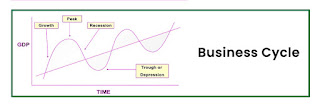Different phases of the Business Cycle - CA Foundation Notes
The natural growth and contraction of product and service production and output through time is referred to as a business cycle.
Different phases of the business cycle
The 4 phases of the business cycle are as follows:
I – Expansion: During this period, production output and employment both expand dramatically. During this time, involuntary unemployment remains at a minimum.
II – Peak: The expansion phase comes to a close here, and the peak is reached. During this time, the company reaches its maximum. The economy reaches its full output but overheats as a result. As cost and sale prices rise, demand falls and the cost of living rises.
III - Contraction: During this phase, the company succumbs to economic pressure and begins to downsize. In contrast to the boom period, output and employment begin to decline. Unemployment is becoming more involuntary.
IV - Trough: During this period, outputs and employment are at their lowest levels. As a result, business owners boost capital investments in order to expand, resulting in increased output. The increased output at low pricing starts to produce sales, and the company enters the expansion phase.
Click below to know
Tag - ca foundation coaching; ca foundation study material; ca foundation course

Comments
Post a Comment
Thank you we will contact ASAP.